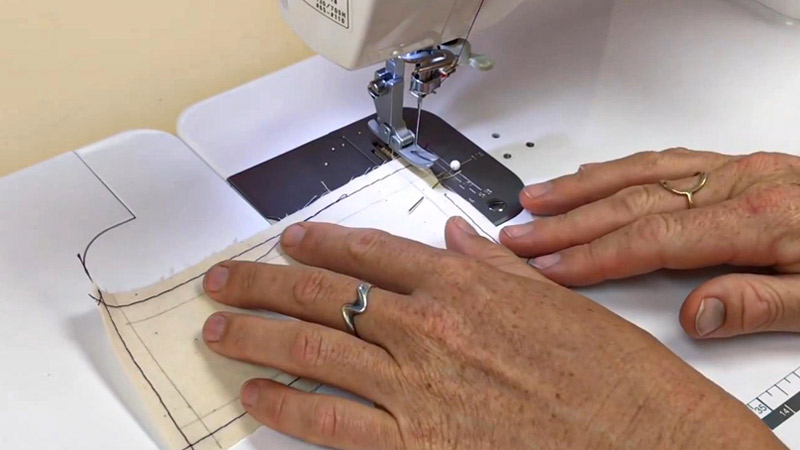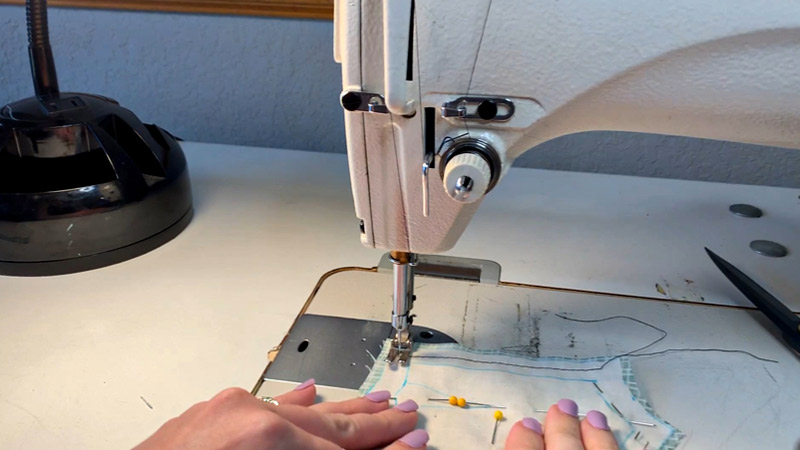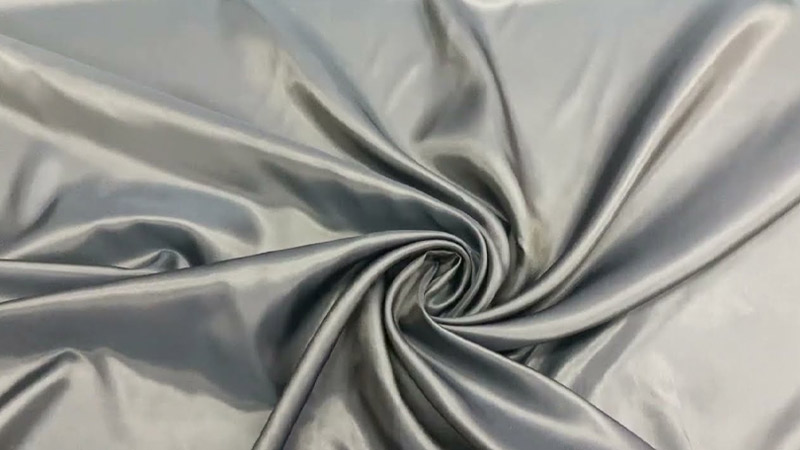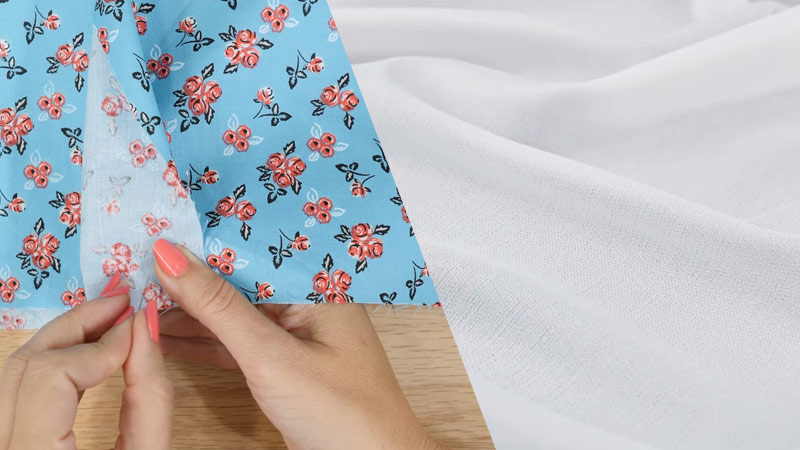Delving into the world of garment construction involves mastering various techniques, and one such method that adds both structure and polish to garments is flat-lining sewing.
Flatlining is a versatile technique where two layers of fabric are treated as one, providing stability, opacity, and a clean finish to the garment.
This method is particularly valuable when working with lightweight or sheer fabrics, ensuring a professional result.
Understanding “What Is Flat Lining Sewing” opens the door to creating garments with enhanced durability and a polished appearance.
In this exploration, we unravel the intricacies of flat lining, shedding light on its applications, benefits, and the art of seamlessly combining fabrics.

What Is Flat Lining Sewing?
Flatlining in sewing refers to a technique where a garment is constructed by sewing two layers of fabric together as if they were one.
This method involves treating the fabric layers as a single entity, typically using basting stitches or temporary hand stitches.
Flatlining provides additional structure, support, or opacity to a garment, especially when working with lightweight or sheer fabrics.
The finished piece gains stability and durability by sewing the layers together before constructing the garment.
This technique is commonly employed when reinforcement is needed, such as bodices or certain parts of a garment, resulting in a more polished and well-constructed final product.
How To Do Flatline Sewing?

Embarking on a sewing project often involves mastering various techniques to achieve desired results. When it comes to creating a more structured garment, flatlining in sewing is a valuable method.
Here are seven simple methods to guide you through flatlining fabric, ensuring your garments are sturdy and polished.
Selecting Compatible Fabrics
Begin by choosing two fabrics – the fashion fabric and lining fabric – that work well together regarding weight, texture, and drape. This ensures a harmonious blend when flatlining.
Pre-Washing Both Fabrics
To prevent differential shrinking, pre-wash both fabrics before starting the flatlining process. This ensures that any potential fabric distortions occur before construction.
Basting the Layers Together
Temporarily secure the fashion fabric and lining fabric with basting stitches or pins along the seam lines. This step provides stability during construction and helps prevent shifting.
Using Temporary Adhesive
Alternatively, consider using a temporary fabric adhesive spray to bond the layers together. This method eliminates the need for basting stitches and is particularly useful for slippery or delicate fabrics.
Hand Stitching
Employ hand-stitching techniques, such as catch stitching or slip stitching, to secure the layers along seam lines. This meticulous approach ensures a clean finish and added durability.
Staystitching
Prior to flatlining, staystitch curved or bias-cut areas on the fashion fabric. This prevents stretching during the flatlining process, ensuring accurate and consistent results.
Combining Flatlining with Interfacing
Enhance the stability of your garment by combining flatlining with interfacing. Apply interfacing to areas that require extra reinforcement, ensuring a balance between structure and flexibility.
Incorporating these seven simple methods of flatlining in sewing will elevate your garment construction, providing a foundation for well-crafted, stable, and aesthetically pleasing creations.
Which Lining Is Best?
When it comes to selecting the ideal lining for your garments, understanding the qualities of various fabrics is essential for successful flat-lining sewing.
Here are seven flat-lining options, each with its unique characteristics and applications, to help you make the best choice for your projects.
Bemberg Rayon Lining

Known for its breathable and moisture-wicking properties, Bemberg rayon lining is a top choice for comfort. It offers a luxurious feel against the skin and is excellent for garments that require a soft and lightweight lining.
Ambiance Lining
Ambiance lining fabric is often chosen for its silky and smooth texture. It provides a sleek finish to garments and is commonly used in dresses and eveningwear, where a luxurious drape is desired.
China Silk Lining
China silk, also known as habotai silk, is a lightweight, smooth fabric perfect for adding opacity to sheer garments. It’s popular for blouses, dresses, and other delicate pieces.
Cotton Batiste
Cotton batiste is a breathable and lightweight option ideal for warm-weather garments. It’s often chosen for its natural feel against the skin and is suitable for lining summer dresses and blouses.
Polyester Lining
Polyester lining fabric is versatile and widely used in various garments. It provides a cost-effective option with durability, making it suitable for both casual and formal wear.
Acetate Lining
Acetate lining is known for its luxurious appearance and smooth finish. It adds a touch of elegance to garments and is commonly used in high-end fashion pieces.
Silk Charmeuse Lining
Silk charmeuse is a premium option known for its luxurious feel and beautiful drape. This lining is often chosen for high-end garments, including bridal and eveningwear, where a luxurious finish is desired.
Consider the specific requirements of your garment, such as breathability, opacity, or luxurious texture, when selecting the best flat-lining fabric.
Each option brings its own advantages to enhance your creations’ overall quality and comfort.
What Is The Difference Between Flat Lining And Interlining?

Here’s the difference between flat-lining and interlining:
| Aspect | Flat Lining | Interlining |
| Purpose | Provides a clean finish, stability, and opacity to garments. Often used for linings in dresses, skirts, and jackets. | Adds warmth, structure, or additional support to a garment. Used for insulation, shaping, or enhancing fabric characteristics. |
| Attachment Method | Flatlining can use various fabrics, such as Bemberg rayon, cotton batiste, polyester, or silk, depending on the desired finish and comfort. | Interlining is placed between the garment fabric and the lining, often stitched or fused to one or both layers. Can be removable or permanent. |
| Material Type | Enhances the appearance, durability, and comfort of the garment. It provides a smoother finish and adds a layer of modesty or warmth. | Interlining materials include fleece, flannel, quilted fabrics, or specialty materials designed for specific effects like shaping or insulation. |
| Functionality | Interlining is placed between the garment fabric and the lining, often stitched or fused to one or both layers. It can be removable or permanent. | Focuses on modifying the garment’s characteristics, like warmth, shaping, or added structure. Often used in outerwear or tailored pieces. |
| Common Applications | Dresses, skirts, jackets, and garments where a smooth, polished finish is desired. | Winter coats, jackets, and garments that require additional warmth, shaping, or structure. Common in tailored or structured designs. |
Understanding the differences between flat-lining and interlining allows sewers to choose the appropriate technique based on their garment’s specific needs and desired outcomes.
FAQs
When is flat-lining used in garment construction?
Flatlining is commonly used when working with lightweight or sheer fabrics. It’s applied to dresses, skirts, and jackets to enhance the overall structure and appearance of the garment.
How is flat-lining different from regular lining?
While regular lining adds a layer inside the garment, flat-lining involves sewing two fabric layers together as if they were one, creating a seamless and stable construction.
What fabrics are suitable for flat-lining?
Various fabrics, such as Bemberg rayon, cotton batiste, polyester, or silk, can be used for flat-lining. The choice depends on the desired finish and comfort.
Can flat-lining be applied to outerwear?
Flatlining is commonly used in outerwear, providing both structure and a smooth finish. It’s especially beneficial in tailored or structured designs like coats or jackets.
Is flat-lining suitable for all sewing skill levels?
Flatlining is a versatile technique suitable for sewers of all skill levels. Beginners can start with simple applications, while advanced sewers can explore complex constructions for tailored pieces.
Conclusion
The art of flat-lining sewing unveils a world of possibilities in garment construction, offering a technique that marries fabrics for both aesthetic and functional purposes.
Whether crafting dresses, skirts, or jackets, flat-lining provides the foundation for a smooth finish and increased garment durability.
This method transcends the realm of mere construction, elevating the overall quality and appearance of the final piece.
As sewing enthusiasts embrace the intricacies of flat lining, they gain a valuable skill that contributes to the creation of polished, well-structured garments.
The journey into flat-lining sewing enriches the craft, ensuring that each garment is a testament to meticulous construction and attention to detail.
Leave a Reply